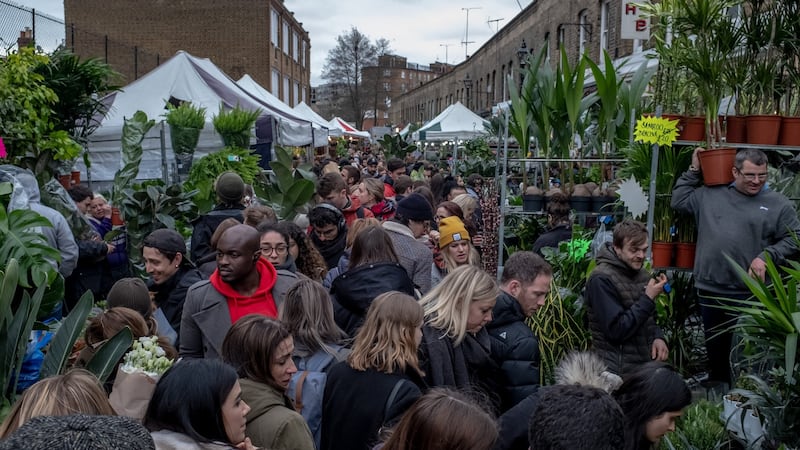Situated halfway between Bethnal Green and uber-trendy Shoreditch in east London, Columbia Road is ground zero for London’s hipster scene; not the broke ones who drink cans of Bavaria, but the rich hipsters who sweat craft beers and often work in high-paying jobs at multinational tech companies.
Any doubts I had about where Columbia Road sat on London’s hipster spectrum were settled on Saturday by the sight of one young man darting across the street from Ravenscroft Park into the Birdcage pub. It was once a decent local hostelry but is now run by hipster favourite Brewdog – my first clue.
The man, who was aged in his late 20s, was wearing shorts, black dress shoes, long white socks pulled down to his ankles, a mullet, a bushy moustache and an “Opel” vintage Ireland jersey. Yet he was English; I heard him shouting back over to his friends at the park gate in a posh, cut-glass accent.
Columbia Road is almost impenetrable on Sundays when its famous flower market is in operation and biblical crowds shuffle along at a snail’s pace. It is more pleasant on Saturdays when the flow of pedestrians is lighter, apart from a snarl-up of drinkers outside the Royal Oak if it’s a sunny day. Then, the road is revealed in all its gentrified, over-priced glory.
READ MORE
It is an attractive old street of two-storey terraced houses, flanked for a bit by an intricate wall of mosaics. Much of the street is lined with vintage bookshops, vintage boutiques, vintage barbers – those hipster soup strainers don’t clip themselves – and specialist coffee shops. Whatever you’d imagine an item might cost, add 20 per cent if it is being sold in a shop on Columbia.

Twenty years ago this was a working-class area but only the well-heeled can move here now. This week on Rightmove, a modest four-bedroomed terraced property was up for rent on the road for £6,300 (€7,560) a month.
East Londoners; fleeced Londoners.
Walking towards Hackney at the eastern end of the road, a Victorian flat complex rose up on the right-hand side. It looked very similar to some of the distinctive old complexes in and around Dublin’s south inner city – around Kevin Street and, developed later, on Bride Street near St Patrick’s Cathedral. Those were built by the Guinness family’s Iveagh Trust housing charity from the late 1890s.
They looked similar because the London and Dublin blocks were built by the same developer. Saturday’s late afternoon sun threw a warm glow on one of the Columbia complex’s towers and its original inscription – Guinness Trust Buildings, 1892.
Edward Cecil Guinness, great grandson of porter tycoon Arthur, set up the Guinness Trust housing charity in 1890 to provide affordable homes for the poor of Dublin and London. One wonders what he would have made of the prices paid in the locality by the hipsters of the East End.
The Irish operation was carved off into a separate entity in 1903 and renamed the Iveagh Trust. The London operation kept its Guinness moniker, and is now one of the biggest housing associations in England. Resembling (to an Irishman) great big slabs of Dublin, large Victorian and Edwardian Guinness Trust buildings are dotted all around London, including in west London on Fulham Palace Road and south of the river at Snowsfields in Bermondsey.
Today, the need for affordable housing in London and across England has rarely been greater. There is a severe housing shortage across much of the country, but nowhere more acute than the capital.
The new Labour government has promised to build 1.5 million new homes over the next five years. Deputy prime minister Angela Rayner has been given the daunting job of delivering them. At the end of this month, chancellor of the exchequer Rachel Reeves sets out the terms of a spending review alongside her first budget. Housing will be central to it. The mood music suggests Rayner and Reeves have been scrapping already as the deputy prime minister seeks more resources.
London councils say they have a £600 million shortfall for housing investment this year – 2024/25 – and £700 million for 2005/26. About 175,000 Londoners remain in council-arranged temporary accommodation, such as B&Bs, while they wait on long-term housing. The shortage is so bad that Labour plans to allow developers to build homes on parts of the green belt, as long as 50 per cent of the stock is made available as affordable homes.
[ Expansion of posh bakery chain Gail’s riles some east London residentsOpens in new window ]
What constitutes “affordable,” meanwhile, remains a relative concept. Rich hipsters can afford to blow £1,600 per week on a modest-sized terrace home on gentrified Columbia Road, but few others can. London’s frothy property prices keep on galloping ahead, while local borough councils and the government, and hard-pressed house-hunters, strain to keep up.














